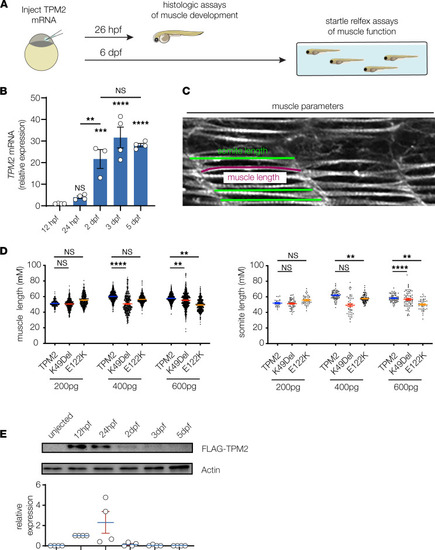Fig. 6
- ID
- ZDB-FIG-220623-85
- Publication
- McAdow et al., 2022 - A pathogenic mechanism associated with myopathies and structural birth defects involves TPM2 directed myogenesis
- Other Figures
- All Figure Page
- Back to All Figure Page
|
Transient overexpression assays in zebrafish. (A) Transient expression assays were used to characterize myogenic defects in zebrafish that expressed TPM2 variants. One cell stage embryos were injected with control or variant-encoding mRNAs and raised under standard conditions to 26 hours postfertilization (hpf) for histological assays or to 6 days postfertilization (dpf) for locomotor assays. (B) Quantitative real-time PCR of zebrafish TPM2 in wild-type embryos, normalized to 12 hpf. n = 4 larvae per sample; 3–4 replicates are shown. (C) Histologic measurements of 26 hpf larvae. Individual slow muscle fibers were traced in ImageJ (NIH) to determine muscle length (magenta line). Somite size was measured 3 times per somite and then averaged to calculate somite length. (D) Pathogenic TPM2 variants caused dose-dependent defects in myofiber length and somite length. A gradient of mRNA doses were injected (200 pg, 400 pg, and 600 pg), and muscle morphology was assessed at each concentration. A dose of 600 pg produced consistent phenotypes in variant-expressing larvae but not in wild-type expressing larvae. Each data point represents an individual muscle fiber or somite. n ≥ 20 larvae per condition. (E) Western blot of injected TPM2. One-cell stage embryos were injected with 600 pg Flag-TPM2 mRNA, and lysates were collected at 12 hpf, 24 hpf, 2 dpf, 3 dpf, and 5 dpf. Robust TPM2 expression was detectable at 12 hpf and 24 hpf. Each data point graphed represents relative expression from 1 independent clutch. n ≥ 30 animals per sample; 4 replicates are shown. Significance was determined by unpaired, 1-tailed Student’s t test versus wild-type TPM2–injected fish. **(P < 0.01), ***(P < 0.001), ****(P < 0.0001). Error bars, SEM. |

